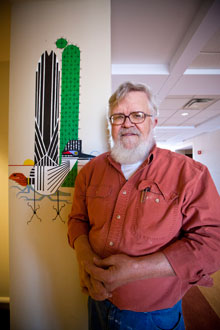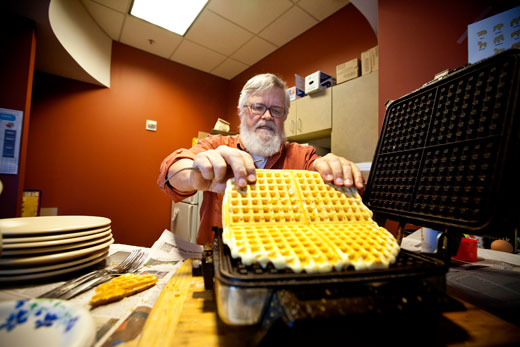It's Thursday up on the fifth floor of Emory's Math and Sciences building, and the familiar scent wafting through the hallways can only mean one thing.
Waffles, and lots of them — homemade, golden brown and hot off the griddle.
The man behind the waffle iron is Woody Hickcox — geologist and climatologist, self-taught watercolorist/muralist, and resident chef.

An example of Hickcox's artwork in the Department of Environmental Studies. Emory Photo/Video.
Hickcox is known as much for creating the colorful artwork that blooms upon walls throughout the Department of Environmental Studies as he is for hosting weekly waffle feasts that draw students, staff and faculty alike.
His murals brighten the entire floor — sprawling, glorious and unexpected.
Upon the blank wall of a staircase, a red-crowned crane takes wing. A tropical fish floats across huge double doors. A New Zealand shrimp frolics upon the wall of a men's room. And peering from around a corner, a portrait of Charles Darwin appears to take it all in. Hickcox's smaller watercolors embellish office nameplates outside nearly every faculty door.
Beneath the artwork and the culinary skill is a man who simply enjoys feeding the senses.
A senior lecturer in the Department of Environmental Studies, Hickcox is preparing to retire in May after nearly 29 years of teaching at Emory. He is married to the Rev. Alice McCracken Hickcox, an electronic text specialist with the Robert W. Woodruff Library.
Hickcox sat down with Emory Report to discuss a life made richer by both the arts and science and his special knack for drawing people together over food.
How did art come into your life?
I've always been the artist in the family. My parents would send out mimeographed Christmas greetings and I would draw on them. When I was in high school and college, my teachers would ask me to produce illustrations for the mimeographs they made for chemistry class. I don't have the fine skill of a real artist. Mostly, I copy images I like, relying on a photographer's eye.
Tell me about your background. Did it influence your art?
I was born in Waterbury, Conn., but raised in Shreveport, La. My father was a geologist who taught and eventually served as dean of students and dean of admission at Centenary College of Louisiana, where I virtually grew up. I've never really been off a college campus.
There came a time that my father-in-law was in hospice in Baton Rouge. He had loved the outdoors and had often taken his five daughters fishing in the Atchafalaya Basin. I would paint 4 x 6 postcards inspired by that area and send him two a week. I've always been a birdwatcher. Growing up, I would spend my summers in Vermont out in the country on a lake. Lots of time to watch birds.
Now, I drive from here to Vermont every year, taking the long way, the scenic route. I'll go out West first [the geological development of Central Utah is a research focus]. Last summer, I logged about 8,000 miles. On those trips, I take pictures of birds. I have a camera with a good, long lens. Then I'll come back and paint images of the birds I've photographed.
How did you develop a love of cooking?
As a kid, I would get hungry and go to the kitchen and ask my Mom, "When do we eat?" And she would say, "Twenty minutes, unless you help." And I would always help. So I've been cooking since grade school. I was kind of a particular eater, also. I wanted to cook things the right way, my way. So I would just cook.
[At Middlebury College] a lot of my fraternity brothers were Jewish guys from New York. We had an open kitchen, which was one reason I joined. I cooked all the time, learned to make doughnuts and what have you. One day a friend asked me to make "bodadolatkes." I didn't know what he was talking about.
He was asking me to make "potato latkes," potato pancakes, essentially. I didn't know how, so he called his mother or grandmother in New York City and got her recipe for latkes. And I've been making them ever since. I had a good friend in graduate school whose grandparents were refugees from Germany. She tasted them and approved. So I knew I had something. Occasionally, I'll make them here.
How did the Waffle Thursday tradition start?
The first year we were in here, I was talking to a class about climate change, how water from the Gulf Stream flows to the North Atlantic and sinks. So we were talking about how when you have fluids of different densities, they will sink and rise. As an example, I talked about mixing waffle batter and whipped egg whites – if you put the waffle batter on top of the egg whites, it will basically turn over.
Well, a lot of students have never seen waffles made from scratch. So I brought in the apparatus to make them. Afterward, one of the students, who's now a physician, said, "Why don't you do waffles every week." So we started making waffles every Thursday. We'll make up a big batch of waffle batter, and since I go to Vermont, we have a ready supply of real maple syrup.
One or two people will often step in to help cook the waffles. You'll usually find a dozen people standing here, talking and eating, and a long line. That's what it's really all about, bringing people together. It creates community.
What do you get out of it?
Almost to an individual, people will say, "Thank you." So you know they appreciate it. Now, it's just a part of life in environmental studies, just what we've always done, trying to break down the walls between students and faculty. And it works. We'll have a significant number of faculty down here eating waffles and chatting with students, and anyone else who comes by, as well.
I've also been known to make scones and biscuits for early morning faculty meetings and biscuits to feed folks between Sunday School and church services at North Decatur Presbyterian Church, so I have a history of feeding people.
Any biscuit-making tips you'd care to share?
I use the recipe on the back of the White Lily flour bag, with adaptations. I know people who swear by lard, but I use butter. I'll keep it in the freezer and grate it into the flour mixture. It makes just a good, homemade Southern biscuit.

